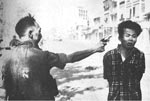|
Photography
and War
Answers
|
Burning
Monk - The Self-Immolation
June
11, 1963
Thich
Quang Duc, a Buddhist monk from the Linh-Mu Pagoda in Hue,
Vietnam, burned himself to death at a busy intersection
in downtown Saigon, Vietnam.. Eye witness accounts state
that Thich Quang Duc and at least two fellow monks arrived
at the intersection by car, Thich Quang Duc got out of the
car, assumed the traditional lotus position and the accompanying
monks helped him pour gasoline over himself. He ignited
the gasoline by lighting a match and burned to death in
a matter of minutes.
David
Halberstam, a reporter for the New York Times covering the
war in Vietnam, gave the following account:
I
was to see that sight again, but once was enough. Flames
were coming from a human being; his body was slowly withering
and shriveling up, his head blackening and charring. In
the air was the smell of burning human flesh; human beings
burn surprisingly quickly. Behind me I could hear the
sobbing of the Vietnamese who were now gathering. I was
too shocked to cry, too confused to take notes or ask
questions, too bewildered to even think…. As he
burned he never moved a muscle, never uttered a sound,
his outward composure in sharp contrast to the wailing
people around him.
Resources:
|
|

|
Execution
of a Viet Cong Guerrilla
February
1, 1968
Photo
credit: Eddie Adams
With
North Vietnam’s Tet Offensive beginning, Nguyen Ngoc
Loan, South Vietnam’s national police chief, was doing
all he could to keep Viet Cong guerrillas from Saigon.
Nguyen
Van Lem was captured, his hands bound, he was brought in
front of the journalists. Loan pulled out his revolver and
immediately executed the prisoner. Loan later insisted that
this was justified because the prisoner had been the captain
of a terrorist squad that had killed the family of one of
his deputy commanders.
Adams
won a Pulitzer Prize for a picture that, as much as any,
turned public opinion against the war. Adams felt that many
misinterpreted the scene and in Time Magazine stated: "The
general killed the Viet Cong; I killed the general with
my camera. Still photographs are the most powerful weapon
in the world. People believe them, but photographs do lie,
even without manipulation. They are only half-truths."
Resources:
|
|
Young
Pan Thi Kim Phuc flees down Route 1 from
the village of Trang Bang. She was burned by naplam dropped
from South Vietnamese planes.
Photo Credit: Huynh Cong "Nick" Ut
June
8, 1972
Resources:
|
|
Ohio
National Guardsmen fire on student protestors at Kent State
University, Ohio, killing 4 and wounding 16. Photo
Credit: John Filo.
May
4, 1970
When
President Richard Nixon said he was sending troops to Cambodia,
the nation’s colleges erupted in protest. At Kent
State some threw rocks. The Ohio National Guard, called
in to quell the turmoil, suddenly turned and fired, killing
four; two were simply walking to class. This photo captured
a pivotal moment: American soldiers had just killed American
kids. Student photographer John Filo won the Pulitzer prize
for this photo. The girl, Mary Ann Vecchio, turned out not
to be a Kent State student, but a 14-year-old runaway. She
was sent back to her family in Florida.
Resources:
|
|
Evacuees
are helped aboard an Air America helicopter perched atop
a Saigon building during the fall of Saigon
April
29, 1975
The Fall of Saigon, on April 30, 1975, was
the capture of the South Vietnamese capital of Saigon by
the North Vietnamese Army. A massive evacuation of diplomats,
foreign nationals, and Vietnamese refugees occurred before
the city fell. It is usually marked as the end of the Vietnam
War.
Within 24 hours of the fall, the city was
renamed Ho Chi Minh City, after the Vietnamese revolutionary
leader Ho Chi Minh. Order was quickly restored to the city,
although the US Embassy, previously the site of an evacuation
by helicopter, was looted.
|
|
